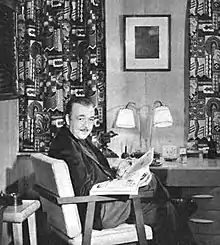Norman Brokenshire
Norman Ernest Brokenshire (June 10, 1898 – May 4, 1965),[1] nicknamed "Sir Silken Speech", was a familiar radio voice in the 1940s, heard as an announcer on such programs as Theatre Guild on the Air. He was the first radio announcer to break from anonymity and use his name on the air.[2]
Norman Brokenshire | |
|---|---|
 Norman Brokenshire in 1953 | |
| Born | Norman Ernest Brokenshire June 10, 1898 Murcheson, Ontario, Canada |
| Died | May 4, 1965 (aged 66) Hauppauge, New York |
| Occupation | Radio announcer |
His autobiography This Is Norman Brokenshire: An Unvarnished Self-Portrait was published in 1954.[3]
Early years
Brokenshire was born near Hudson Bay to a minister father who preached in remote sections of Canada. After coming to the United States in 1918, he served in the U.S. Army as an artillery man.[1]
Radio
Brokenshire's broadcasting career began in 1924 at WJZ, where he immediately attracted attention. The New York Herald Tribune asked, "Who is this new AON? He speaks with perfect enunciation and exceptional modulation."[4] That same year, he became the first announcer to cover a political convention when he worked the Democrats' meeting in New York.[2]
In the summer of 1927, Brokenshire had his own program, A Half Hour with Norman Brokenshire on WPG.[5] By 1929, he was an announcer for CBS.[6]
Brokenshire was known for his folksy greeting, "How do you do, ladies and gentlemen, how do you do." By 1947, he was earning $50,000 annually.
Old-time radio programs for which Brokenshire was the announcer included The Chesterfield Hour, Chesterfield Cigarettes Presents "Music That Satisfies" (also known as Chesterfield Time),[7] Eddie Cantor's Follies, Inner Sanctum Mystery, and Major Bowes Amateur Hour.[2]
In 1961, Brokenshire returned to radio "after an absence of some years, ... doing commercials on radio station WMMM in Westport, Conn."[8]
Television
He became an announcer for television in the 1950s and had his own ABC series, The Better Home Show, (1951–52) offering instruction in home crafts and renovation.[9] He also hosted the syndicated series Handy Man in 1952.
His wife, Eunice Brokenshire, was a radio program director in the 1920s. His autobiography, This Is Norman Brokenshire, was published in 1954 by David McKay.
References
- DeLong, Thomas A. (1996). Radio Stars: An Illustrated Biographical Dictionary of 953 Performers, 1920 through 1960. McFarland & Company, Inc. ISBN 978-0-7864-2834-2. P. 42.
- Taft, William H. (2015). Encyclopedia of Twentieth Century Journalists. Taylor & Francis. ISBN 9781317403241. Retrieved 30 December 2015.
- "WorldCat". WorldCat. Retrieved June 26, 2019.
- Barnouw, Erik. A History of Broadcasting, Oxford University Press, 1966.
- "Turning the Radio Dial". Pennsylvania, Harrisburg. The Evening News. August 1, 1927. p. 13. Retrieved December 30, 2015 – via Newspapers.com.

- "Presenting Medal to Byrd Operator at Show Tonight". New York, Brooklyn. The Brooklyn Daily Eagle. September 29, 1929. p. 31. Retrieved December 29, 2015 – via Newspapers.com.

- "BING magazine". bingmagazine.co.uk. Retrieved June 26, 2019.
- "Norman Brokenshire Back in Broadcasting". Wisconsin, Appleton. The Post-Crescent. May 22, 1961. p. 12. Retrieved December 29, 2015 – via Newspapers.com.

- Lanigan, Bob (May 25, 1951). "Bob Lanigan's TV Review". The Brooklyn Daily Eagle. The Brooklyn Daily Eagle. p. 15. Retrieved December 29, 2015 – via Newspapers.com.

- "Norman Brokenshire, Radio Announcer, Dies". Wisconsin, La Crosse. The La Crosse Tribune. May 5, 1965. p. 23. Retrieved December 30, 2015 – via Newspapers.com.

- "News Announcer Brokenshire Dies In NY Hospital". California, Fresno. The Fresno Bee The Republican. May 5, 1965. p. 17. Retrieved December 30, 2015 – via Newspapers.com.
